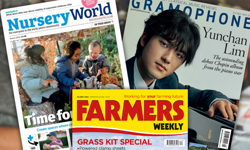
The health and longevity of most magazines now goes hand-in-hand with an ability to find and effect a successful subscriptions strategy. So, it’s hardly surprising that there is much from the experience of New Scientist – winner of Marketing Team of the Year at this year’s PPA Awards – from which others can learn.
Praised by the judges for its cross-brand collaborations, fresh new campaigns and key data insights, the team “absolutely smashed their targets” to achieve incredibly impressive subscription turnover, the commendation read.
Leading the approach is New Scientist Marketing Director Jo Adams, who’s worked in subscriptions marketing for over twenty years. After starting out at BBC Worldwide, she spent time at The National Magazine Company, TSL Education and Bauer – where, by the time she left, she was responsible for 70 titles.
Following a brief stint at The Spectator, she then took up her current role, which she has held for the past two years.

If there is one thing Adams has learned from her various roles and experiences at different companies, she says, it is the extent to which the subscriptions function within different publishers varies “in terms of levels of importance, and so in the interest and support it gets”.
And the common denominator uniting the most proactive? Data-driven insights that help find answers in today’s complex world.
“We have lots of data,” she explains; “We continually monitor who is coming into the top of the funnel from different regions, what content they are reading, whether they are reading free content, how many are hitting the barrier, the articles which are converting – all on a weekly basis.”
“We have channel targets as well for the emails we send out and newsletters, as well as campaign marketing.”
Data-driven insight – along with lifetime value – has been a key focus for her ever since her days at the BBC, Adams says. And she adds that irrespective of the scale of a publishing business or, indeed, the size of its portfolio of brands, the subscriptions challenge remains the same.
“Whether you publish a single title or are a multi-title publisher,” she notes, “you have lots of plates to keep spinning – most importantly, volume, revenue and yield.”
With customer revenue accounting for 70% to 75% of New Scientist’s revenue, subscriptions play a very important role – so important, in fact, that subscriptions KPIs are shared with everyone across the business.
Gone are the days where it was sufficient to be a generalist.
Changing face of subs marketers
Like every paid-for magazine, the decline in newsstand sales over many years has forced subscriptions teams to expand their marketing expertise and today, subscriptions marketers are data analysts and channel experts, Adams explains.
Gone are the days where it was sufficient to be a generalist. Focus now is on analysis to pinpoint what drives conversion, then how best to effect it. Not to mention driving up yield. Reducing churn. And improving the overall customer experience.
The team, which constantly monitors multiple data points across every subscriber marketing activity, is now set up to quickly act on anything the data reveals.
Digital marketing is New Scientist’s number one subscriptions marketing channel closely followed by email.
Social media plays an important strategic role, and Facebook is the one place where the title runs trial subscriptions by targeting lookalike audiences – groups of Facebook users who are non-subscribers but whose past content consumption, demographic or location, for example, match those of existing New Scientist subscribers.
Meanwhile, time and effort are split equally between subscriptions renewal and new subscriber acquisitions, she continues. The heads of customer experience and acquisitions work hand in hand – each knowing what the other is doing and what they have achieved so as not to generate too many new subscribers with a high propensity to churn.
The Covid-19 pandemic has been both a major challenge and an important opportunity for New Scientist to further hone its subscriptions strategy this year by listening and learning – about being agile and responsive, and about understanding what content best converts.
After New Scientist was mentioned by Matt Hancock in one of his daily briefings during the early phase of the pandemic – “I knew I would get tough questions from New Scientist”, he publicly said – a Tough Questions-themed email and online marketing campaign was created within hours, involving messaging around the importance of trusting the data and trusting science.
A decision was taken early on to make New Scientist’s basic Covid-19 news free online with more in-depth content behind its hard paywall. There was no trial strategy as such, and pricing was maintained – in some cases, even increased. And in the period that followed, subscriptions grew by 32% ahead of target.
Another early decision was to remove its print-only subscription option at the start of the pandemic – due to concerns about its ability to maintain physical delivery throughout the lockdown – and raise the price of its print+digital subscription bundle. With subsequent analysis showing the move generated significant numbers of people taking bundles, this too seems to have paid off.
Do more of what works and less of what doesn’t is one clear message from New Scientist’s subscriptions strategy. Which considered in isolation, may sound somewhat simplistic. But the key to the winning formula lies in how it achieves this, and that’s with a firm and clear-eyed commitment to test everything, learn and continually evolve.
The Covid-19 pandemic has been both a major challenge and an important opportunity for New Scientist.

You can hear Jo Adams being interviewed by Ciar Byrne on a recent episode of The InPublishing Podcast, which was sponsored by Acorn Web Offset, the Yorkshire-based specialist A5 and A4 magazine printer.
This article was first published in InPublishing magazine. If you would like to be added to the free mailing list, please register here.












